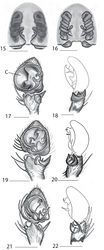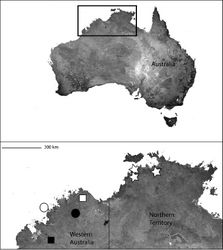Karaops larryoo
| Notice: | This page is derived from the original publication listed below, whose author(s) should always be credited. Further contributors may edit and improve the content of this page and, consequently, need to be credited as well (see page history). Any assessment of factual correctness requires a careful review of the original article as well as of subsequent contributions.
If you are uncertain whether your planned contribution is correct or not, we suggest that you use the associated discussion page instead of editing the page directly. This page should be cited as follows (rationale):
Citation formats to copy and paste
BibTeX: @article{Crews2011ZooKeys99, RIS/ Endnote: TY - JOUR Wikipedia/ Citizendium: <ref name="Crews2011ZooKeys99">{{Citation See also the citation download page at the journal. |
Ordo: Araneae
Familia: Selenopidae
Genus: Karaops
Name
Karaops larryoo Crews & Harvey, 2011 sp. n. – Wikispecies link – ZooBank link – Pensoft Profile
Type material
Holotype male (WAM T93/1333): north of Larryoo, Drysdale River National Park, 14°51'S, 126°49'E, Western Australia, Australia, 12.VI.1992, M.S. Harvey, J.M. Waldock. Paratype: same data as holotype, 1♂ (WAM T93/1332).
Etymology
This species is named for the type locality, and is to be treated as a noun in apposition.
Diagnosis
Males can be differentiated by the presence of three processes on the palpal RTA and the tip of the conductor being heavily sclerotized and directed basally (Fig. 21). Females unknown.
Description
Holotype:Color: carapace yellow-brown, with slightly darker marks medially; sternum pale yellow-brown; chelicerae pale yellow with darker infuscations anteriorly; maxillae pale yellow-brown; labium pale yellow-brown; abdomen dorsally yellow-brown with darker markings; ventrally pale yellow-brown; legs with all segments clearly annulated. Cephalothorax:setae short, stout, rodlike; 0.89 times longer than broad; fovea longitudinal, broad, very shallow. Eyes:AER slightly recurved; PER recurved; PME larger than AME, PLE largest, ALE smallest; eye group width 1.52; eye diameters, AME 0.17, ALE 0.11, PME 0.24, PLE 0.34; interdistances AME-ALE 0.31, PME-PLE 0.23, ALE-PLE 0.16, AME-PME 0.04; ocular quadrangle AME-AME 0.43, PME-PME 0.85; clypeus 0.09 high. Mouthparts:chelicerae with a few stout setae medially and anteriorly; lateral boss present, smooth; promargin with 3 teeth, retromargin with 2 teeth; maxillae longer than broad, with tuft of conspicuous setae distally; labium distally rounded. Sternum:0.94 times longer than broad, posteriorly indented. Pedipalp:femur, spination dorsal 0–1–2; retrolateral tibial apophysis with 3 processes, dorsal apophysis long, slender and slightly curved, median apophysis broad and triangular, ventral apophysis small with a squarish tip; retrolateral basal cymbial process present; cymbial scopulae absent; cymbium oval to triangular, angled bottom right; conductor large and quadrangular, with a sclerotized tip directed basally; embolus long and slender, beginning at 6 o’clock, terminating at 1 o’clock, not following edge of cymbium, but more toward the center of the bulb; MA long, slightly curved, distally spatulate, directed laterally then distally (Fig. 21). Legs:leg I only slightly shorter than legs II, III and IV; leg formula 3421; scopulae absent on all legs; tarsus I–IV with strong claw tufts; pr claws with 1 or 2 small teeth; spination: leg I, Fm pr 1–1–0, d 1–1–1, rl 0; Ti d 0, v 2–2–2–2–2; Mt 0; Ti and Mt I and II with very weak spines; leg II, Fm pr 0, d 1–1–1, rl 0; Ti v 2–2–2–2–2; Mt 0; leg III, Fm pr 0, d 1–1–1, rl 0; Ti 0; Mt 0; leg IV, Fm pr 0, d 1–1–1, rl 0; Ti 0; Mt 0. Abdomen:without terminal tufts of setae. Dimensions: Total length 5.61. Cephalothorax length 2.69, width 3.01. Sternum length 1.48, width 1.55. Abdomen length 3.22, width 2.98. Pedipalp: Fm 0.81, Pt 0.41, Ti 0.45, Ta 0.81, (total) 2.48. Leg I: Fm 4.16, Pt 1.41, Ti 3.89, Mt 3.28, Ta 1.45, (total) 14.19. Leg II: Fm 5.49, Pt 1.59, Ti 4.71, Mt 3.81, Ta 1.82, (total) 17.42. Leg III: Fm 6.01, Pt 1.48, Ti 4.77, Mt 4.38, Ta 1.68, (total) 18.32. Leg IV: Fm 5.47, Pt 1.19, Ti 4.42, Mt 3.89, Ta 1.61, (total) 16.58.
Natural history
Collected from under rocks.
Distribution
The type locality only (Map 5).
Original Description
- Crews, S; Harvey, M; 2011: The spider family Selenopidae (Arachnida, Araneae) in Australasia and the Oriental Region ZooKeys, 99: 1-104. doi
Images
|

